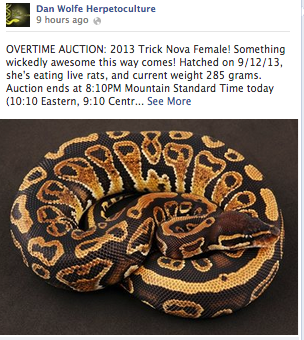Do Auctions Damage the Reptile Industry?
Justin Kobylka – 2/25/14
Note: This article deals with the inner workings of the reptile industry and more specifically the Ball Python market. I’m not writing this as a judgement to those named or unnamed. It is my intention to explore this topic and its pros and cons. At the end of this article please take the time to read some counter points by Mike Wilbanks posted in the comments section.
There’s a trend afoot in the reptile business where private breeders are using auctions to sell their snakes. This initially sprung up on Facebook where a seller would post an animal photo and allow bidders to place their bids below. Several people found success by amassing a great number of people watching their FB page and sold mostly low-end animals. These auctions were typically a situation where a reptile wholesaler would purchase or consign excess animals from breeders and auction them for a profit. Ben Seigel’s auctions have been dominating this space. Often animals even approach or exceed retail pricing in bidding wars before the auction closes.
When this started I viewed it as mostly harmless to the industry as a whole. Mostly these were low-demand, inexpensive animals. Breeders were selling the animals to this 3rd party for a negotiated price that they were comfortable with. They were happy, the middle-man (auctioneer) would have a margin and the customer would receive a great deal.
This began to change though as larger breeders started supplying these auctions from the background with more and more valuable animals.
 Private breeders began to offer auctions of their own, direct to their fans of their Facebook page. Initially, breeders were giving their customers a chance to get a good deal and at the same time move out some excess animals that were either low demand or not important to their breeding plans. I also tried this and saw no harm in it. I offered a couple dozen auctions over my Facebook page, one per week. These were animals that I considered either low demand, or sometimes it was just to give an opportunity for bidders to get a deal.
Private breeders began to offer auctions of their own, direct to their fans of their Facebook page. Initially, breeders were giving their customers a chance to get a good deal and at the same time move out some excess animals that were either low demand or not important to their breeding plans. I also tried this and saw no harm in it. I offered a couple dozen auctions over my Facebook page, one per week. These were animals that I considered either low demand, or sometimes it was just to give an opportunity for bidders to get a deal.
I stopped doing auctions after a few months because it just didn’t feel right to me to on one hand to sell an animal at retail pricing, then the next day offer a similar animal to the highest bidder.
 Soon this trend of breeders using FB auctions began to widen. Several larger-name breeders began auctioning medium and high-end animals at low or no-reserve auctions. Two of these on my FB feed are Matt Lerer and Loxahatchee Herp Hatchery. Many of the animals auctioned are not yet common and are still in a phase where the small guy can legitimately make money producing them.
Soon this trend of breeders using FB auctions began to widen. Several larger-name breeders began auctioning medium and high-end animals at low or no-reserve auctions. Two of these on my FB feed are Matt Lerer and Loxahatchee Herp Hatchery. Many of the animals auctioned are not yet common and are still in a phase where the small guy can legitimately make money producing them.
 Furthermore, Dan Wolfe (who is retiring from the industry) has been liquidating portions of his collection via FB auction, selling snakes for pennies on the dollar compared to his previous asking prices. Presumably these same projects were sold at full price in the months prior to his retirement announcement.
Furthermore, Dan Wolfe (who is retiring from the industry) has been liquidating portions of his collection via FB auction, selling snakes for pennies on the dollar compared to his previous asking prices. Presumably these same projects were sold at full price in the months prior to his retirement announcement.
I’ve been watching auctions closely over the past few months and even closer while writing this piece. I’ve seen many times that with good participation, animals will auction for even more than standard industry pricing. As long as the audience for the auction is sufficiently large, Auctions can work quite well for animals that are both in high demand and relatively affordable. Coral Glows / Bananas for example have been consistently doing very well at auction, simply because they are a fantastic mutation that has a large market demand and are affordable to many people.
Taking the Auction trend off Facebook:
The most recent development is the dedicated reptile auction site, Reptile Ring (previously Reptile Bay).
Reptile Ring creator, Mike Wilbanks, states that FB auction success is why he launched the site. In my research on this topic, I spoke with Mike at length about his site and its goals.
This newest iteration offers a dedicated site to those interested in reptile auctions, instead of using the Facebook platform. This helps on technical grounds, by bringing more bidders to a single site for auctions. Its a positive step forward, because it conglomerates traffic and keeps the auctions in view to bidders.
Breaking it down:

Where auctions can disrupt the market is on higher-end animals that have either not yet garnered enough public interest yet or are more expensive. It may force a sale at a time when there may be few or no customers in the market at retail pricing. These premium auctions can directly damage the seller’s customers. It affect both the buyers and the health of the industry as a whole.
Here’s why: The stable breeder industry only exists because many buyers purchase animals in the hopes that they can reproduce them and sell them, either for profit or to cover the expenses of their hobby. Those of us who are professionals in the industry have a responsibility to maintain a market on investment animals, or we have no business asking our customer’s money.
Why can these supposedly valuable animals sell so cheaply at auction?
Auctioning high-end animals exacerbates long-standing issues within our industry. Premium and rare mutations and combos have a narrower market than $100 pet snakes. Selling a high-end animal requires a buyer who has two components. They must have both the desire to buy a particular mutation and the financial means to do so. The person who will buy your $6k or $10k mutation may not be in the market at any given time. They may be looking for a different mutation / combo, or they may not currently have the financial means. Maybe they’ve not decided which mutations to purchase.
 This is true for any expensive product. For example your local Mercedes dealership depends on buyers who wants to buy a Mercedes specifically and has the means to do so. Mercedes will make a certain number of vehicles in a model year and they set a price, knowing that not all of them will sell in the first month. There will be a certain percentage of potential buyers who will come in each month until the new model is released.
This is true for any expensive product. For example your local Mercedes dealership depends on buyers who wants to buy a Mercedes specifically and has the means to do so. Mercedes will make a certain number of vehicles in a model year and they set a price, knowing that not all of them will sell in the first month. There will be a certain percentage of potential buyers who will come in each month until the new model is released.
The misunderstanding of this fact is the #1 cause for volatility in the high end Ball Python market. Let’s take a random example, let’s say an awesome new mutation comes out. So as not to step on anyone’s toes, we’ll call it the “hair ball”. Let’s say that the Hair has been on the market for a couple years and there are two initial breeders with this mutation and 3 other breeders have invested big money to purchase male Hair balls. So now there are 5 breeders who have them available this season, a total of 15 animals we’ll say.
What will likely happen is several of these breeders will offer animals to the market at the same time. There will be a couple of buyers in the market early on that will purchase them at asking price. After those people have purchased, it might be weeks, a month or more until other buyers who meet both criteria (have the means and desire to purchase) enter the market. During this time, the other sellers of this morph often incorrectly assume that the reason they can’t sell is because their price is too high. The reality is there may be 20 or more people in the market over the course of the season at the retail price, but at any given moment, there may be few or temporarily none.
So out of fear, they drop the price, tarnishing their own brand in the process, hurting their own pockets and the that of anyone who has already purchased the mutation, or will in the near future. Even worse, they may try to auction the animals in a market where there are temporarily no buyers at retail. No one will be more damaged than their own customers.
Auctioning a mutation who’s value has not yet been established: For a great mutation to have a full market cycle, it needs to have its value established before it’s offered to a wide market. Some mutations just simply don’t look like much by themselves, but are key to so many important future combos. Some of the most crucial genes in our industry were simply not game changers at first glance. I’m talking about Enchis, Vanillas, Fires, YB, Spotnose and even some the originals such as Hypos and Pastels. If a breeder decides to auction off a new subtle mutation before it has proven market value, the entire life cycle of that mutation is interrupted. It will sell for very little simply, because buyers will be taking a gamble as to what its future is. This is another irresponsible use of an auction. Breeders with a new gene should work to establish value, or sell privately to someone who will.
A case for buying direct from a breeder:
There are so many advantages to doing business the “old fashioned way”, direction patronizing a private breeder:
- You can choose a specific animal or group instead of building a collection based on a smattering of what may be available via auction.
- Customer service! Many of the well known breeders in this industry are not there by accident. They are there because they deliver high-quality animals and service after the sale. This is not replicated via an auction conglomeration site.
- By directly patronizing breeders that offer fantastic animals and service, it allows the best practices in the industry to succeed and create a better industry for tomorrow. Patronize the reptile industry that you wish to be a part of.
- Buying direct builds a relationship. Every successful breeder can point to someone else who helped them along the way. Patronizing quality breeders invests them in your success.
My conclusions:
- Auctions are here to stay, people clearly enjoy purchasing animals in this way.
- Auctions of lower-end or wide appeal animals with a great customer following are a legitimate marketing tool to sell snakes at solid pricing. I don’t see this as any more damaging than the classified ads that we are all used to.
- Auctions of higher-end, rare or investment animals may have a critical issue. They will force a sale at a time when there may be few or no customers in the market at retail pricing. These auctions can directly weaken the structure that allows us all to enjoy the breeder market on Ball Pythons.
- Auctions are not the ideal way to build a collection, because of gaps in availability and limited selection.
- Auctions aren’t as conducive to building a relationship with a breeder.
Responsible breeders have a commitment not only to their customers but to the industry as a whole. I will always seek to thoughtfully operate in a way that will not compromise the market that my customers are selling in.
I challenge my readers to please participate in the reptile market so as to promote its long-term health. Patronize breeders who are responsible with their sales, auctions or otherwise. Spend money with those who are working for the long-term success of their customers.
Justin Kobylka
PS. When I posted this article Mike Wilbanks asked for an opportunity to make some counter points. In the interest of a full conversation on this topic, please read his points in the comments below.

